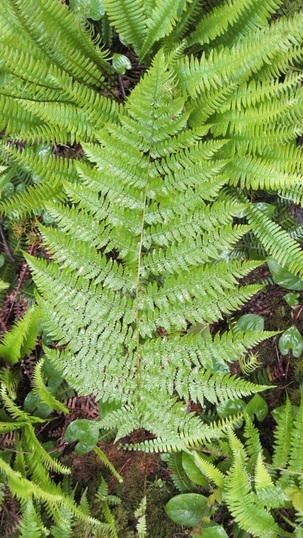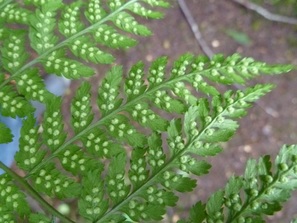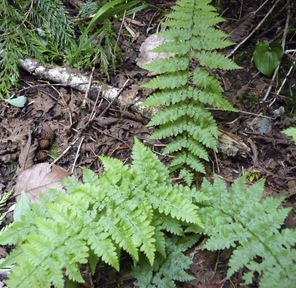Lady fern, subarctic lady fern • Athyrium filix-femina ssp. cyclosorum
Lady fern fronds on Calvert Island. Left photo by Julia Fisher. Upper right photo of oblong or horseshoe-shaped sori. Photo by ES470 student. Lower right photo by Chanda Brietzke.
Identification
Lady fern is a large, erect fern that can grow to 2 m (6') tall. The rhizomes grow vertically and may be visible at the base of the fronds, which grow up and out from this central rhizome. Lady fern fronds are diamond shaped, tapering at both ends (as seen in both photos, above). Blades are 2-3 times pinnate.
Oblong or horseshoe shaped sori are located on the underside of leaflets (see upper right photo, above). Sori house the sporangia, which produce spores for reproduction.
Habitat & Range
Lady fern grows in areas with high moisture regimes, such as moist to wet forests, swamps, and stream banks, as well as in open forests, thickets, meadows, clearings and on rock outcrops. It is found at all elevations.
Its range extends across a large part of North America, excluding northeastern Canada and the southeastern US. It is also found in northeast Asia.
Similar Species
Alpine lady fern (Athyrium distentifolium subsp.americanum) has essentially the same form as lady fern, but it is smaller, less common, and found at higher elevations.
At lower elevations, lady fern can easily be mistaken for the spiny wood fern (Dryopteris expansa) or bracken fern (Pteridium aquilinum). However, both of these species have triangular blades as opposed to the diamond-shaped blades characteristic of lady fern. Bracken fern does not grow from a central point like lady fern and spiny wood fern. .
Human Uses
Lady fern fiddleheads were commonly eaten by many Indigenous Peoples of the Pacific Northwest. They were typically boiled, baked, or eaten raw with grease. Today, fiddleheads of this species are also harvested by indigenous and non-indigenous people alike, for their own consumption or to sell at spring markets. Lady fern is one of three species in the region that can be harvested for fiddleheads. Recipes for fiddlehead stir fry, quiche, pickled fiddleheads and many others can be found here.
Lady fern fronds were also used by Indigenous Peoples of the Pacific Northwest as mats to dry berries.
This species is also a horticultural plant.
iNaturalist
https://www.inaturalist.org/taxa/61002-Athyrium-filix-femina-cyclosorum
Lady fern is a large, erect fern that can grow to 2 m (6') tall. The rhizomes grow vertically and may be visible at the base of the fronds, which grow up and out from this central rhizome. Lady fern fronds are diamond shaped, tapering at both ends (as seen in both photos, above). Blades are 2-3 times pinnate.
Oblong or horseshoe shaped sori are located on the underside of leaflets (see upper right photo, above). Sori house the sporangia, which produce spores for reproduction.
Habitat & Range
Lady fern grows in areas with high moisture regimes, such as moist to wet forests, swamps, and stream banks, as well as in open forests, thickets, meadows, clearings and on rock outcrops. It is found at all elevations.
Its range extends across a large part of North America, excluding northeastern Canada and the southeastern US. It is also found in northeast Asia.
Similar Species
Alpine lady fern (Athyrium distentifolium subsp.americanum) has essentially the same form as lady fern, but it is smaller, less common, and found at higher elevations.
At lower elevations, lady fern can easily be mistaken for the spiny wood fern (Dryopteris expansa) or bracken fern (Pteridium aquilinum). However, both of these species have triangular blades as opposed to the diamond-shaped blades characteristic of lady fern. Bracken fern does not grow from a central point like lady fern and spiny wood fern. .
Human Uses
Lady fern fiddleheads were commonly eaten by many Indigenous Peoples of the Pacific Northwest. They were typically boiled, baked, or eaten raw with grease. Today, fiddleheads of this species are also harvested by indigenous and non-indigenous people alike, for their own consumption or to sell at spring markets. Lady fern is one of three species in the region that can be harvested for fiddleheads. Recipes for fiddlehead stir fry, quiche, pickled fiddleheads and many others can be found here.
Lady fern fronds were also used by Indigenous Peoples of the Pacific Northwest as mats to dry berries.
This species is also a horticultural plant.
iNaturalist
https://www.inaturalist.org/taxa/61002-Athyrium-filix-femina-cyclosorum
References
Athyrium filix-femina subsp. cyclosorum (L.) Roth (Rupr.) C. Chr. lady fern; subarctic ladyfern. In Klinkenberg, Brian. (Ed.). E-Flora BC: Electronic Atlas of the Plants of British Columbia. Lab for Advanced Spatial Analysis, Department of Geography, University of British Columbia, Vancouver. Accessed on 03/04/2013.Athyrium filix-femina (L.) Roth ssp. cyclosorum (Rupr.) C. Chr. subarctic ladyfern. USDA Plants Profile. Accessed 06/04/2013.
Fern Fiddleheads: The Succulent Stalks of Spring. Forager's Harvest. Accessed 06/04/2013.
Pojar, J. and MacKinnon, A. (2005). Plants of Coastal British Columbia, Revised. Vancouver, BC: Lone Pine Publishing. P. 422.
Authors and editors of page
Beatrice Proudfoot, Chanda Brietzke and Brian Starzomski (2016).
Athyrium filix-femina subsp. cyclosorum (L.) Roth (Rupr.) C. Chr. lady fern; subarctic ladyfern. In Klinkenberg, Brian. (Ed.). E-Flora BC: Electronic Atlas of the Plants of British Columbia. Lab for Advanced Spatial Analysis, Department of Geography, University of British Columbia, Vancouver. Accessed on 03/04/2013.Athyrium filix-femina (L.) Roth ssp. cyclosorum (Rupr.) C. Chr. subarctic ladyfern. USDA Plants Profile. Accessed 06/04/2013.
Fern Fiddleheads: The Succulent Stalks of Spring. Forager's Harvest. Accessed 06/04/2013.
Pojar, J. and MacKinnon, A. (2005). Plants of Coastal British Columbia, Revised. Vancouver, BC: Lone Pine Publishing. P. 422.
Authors and editors of page
Beatrice Proudfoot, Chanda Brietzke and Brian Starzomski (2016).







